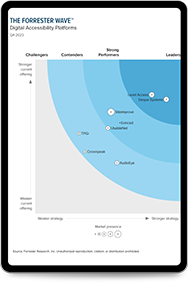ADA Title II Updates: The DOJ’s New Rule
Oct 7, 2024
For years, digital accessibility advocates, along with state and local governments, have expressed frustration over the lack of clarity in the Americans with Disabilities Act (ADA) and the scope of Title II, particularly regarding the accessibility of digital experiences. That will now change, at least in part.
In April 2024, the U.S. Attorney General signed a final rule addressing the accessibility of digital experiences under Title II of the ADA. This rule requires state and local governments to ensure that their services, programs, and activities meet web accessibility standards and are accessible to individuals with disabilities.
This rule was originally proposed in August of 2023 by the U.S. Department of Justice (DOJ) and marks a continuation of the DOJ’s longstanding efforts to clarify the ADA’s application to the digital world.
Not sure if your organization needs to comply or which standards apply to you?
In this post, I’ll explain the DOJ’s new rule under Title II of the ADA, including what kinds of organizations are impacted. I’ll also outline what compliance means, in practical terms, and provide recommendations for aligning with these requirements ahead of the DOJ’s deadlines.
Visit our Title II resource hub for a clear understanding of ADA Title II requirements and guidance on how to achieve compliance.
What are the ADA compliance requirements under Title II?
The final rule, which has been published in the Federal Register, outlines specific accessibility requirements to ensure governments’ digital experiences are accessible to people with disabilities and therefore more inclusive for all constituents.
The new rule’s digital accessibility standards apply to state, local, and district government entities’ websites and mobile apps, and include digital documents (such as PDFs, word-processing documents, spreadsheets, and presentation files). The rule states that these digital assets and experiences need to conform with the Web Content Accessibility Guidelines (WCAG) 2.1, Levels A and AA.
In addition, the rule applies to publicly available web content, including video and audio content and new social media posts. However, the rule provides exceptions for some types of content, such as unchanging, archived materials on a website.
The language of the final rule confirms that measuring WCAG conformance will require some flexibility, since digital content changes frequently and 100% conformance at all times may not be a readily achievable requirement.
The rule specifies a few exceptions where public entities are not required to fully conform with WCAG standards, such as when doing so would impose an undue burden on the organization or significantly change the core functionality of a digital experience.
A digital experience that doesn’t fully conform to WCAG can still meet the rule’s requirements if any violations have a “minimal impact on access,” allowing individuals with disabilities to use the experience as effectively as those without disabilities. Organizations may also offer alternative accessible versions of content, but only when technical or legal constraints make it impossible to make the original content accessible.
What about web content created by third parties?
To comply with the rule, governments need to ensure that all their web and mobile experiences are accessible, including digital experiences from third-party vendors and agencies.
Specifically, the rule states that any digital content that a public entity “provides or makes available” to users must meet accessibility standards, whether this content is provided directly by the public entity (e.g., published to a government’s own website) or by a third-party organization as part of a contractual, licensing, or other agreement. For example, if a city government contracts with a third-party mobile app provider to collect parking payments, the mobile app must conform with WCAG 2.1 A and AA.
Why were updates to ADA Title II made?
According to the DOJ, the proposed updates to ADA Title II address the fact that many state and local governments now provide most of their services, programs, and activities online and via mobile apps. This development has increased the risk that people with disabilities encounter barriers to accessing essential services, as well as barriers to participating in essential civic activities—like attending a town meeting, or even voting.
In addition, both public entities and private businesses are facing mounting legal action surrounding the inaccessibility of digital experiences and content, with many lawsuits and demand letters alleging non-compliance with the ADA. As a result, many organizations have sought clarity from the federal government over what ADA compliance means, practically, when it comes to digital experiences. The DOJ’s new rule offers this clarity by providing documented technical standards (WCAG 2.1 A and AA) against which to measure compliance.
“We will continue to use every tool that we have, including our enforcement authority, to ensure that people with disabilities are not treated like second class citizens when it comes to online services.”
— Associate Attorney General Vanita Gupta (justice.gov)
Who is impacted by this new accessibility rule?
The rule applies to state, local, and other special or district governments, encompassing all government agencies, services, and organizations, as well as organizations they’ve contracted to run programs on their behalf. The DOJ calls these institutions public entities. Other public entities include:
- Public schools, community colleges, and public universities
- Public hospitals and public healthcare clinics
- State and local courts
- Public libraries
Organizations that sell technology, such as education technology and web platforms, to public entities also need to make sure their products are accessible. While vendors may not directly have to comply with the new rule’s requirements, the public entity—their buyer—does. And with this new rule in place, they need to tighten their procurement requirements to ensure all purchased products and services conform with WCAG 2.1 A and AA.
If you want to sell into this market, following these web accessibility standards is a requirement. Check out the DOJ’s fact sheet for a more in-depth list of impacted organizations and services.
What is the ADA Title II compliance deadline?
The final rule goes into effect in June of 2024, 60 days after its publication in the Federal Register. After this effective date, public entities have either two or three years to ensure that their web content and mobile apps conform with WCAG 2.1 A and AA standards. Specific timelines for compliance vary based on organizations’ size, with extra time allotted to smaller public entities. The requirements are as follows:
- Public entity with a total population of 50,000 or more: compliance within two years of the date of publication (by April 2026)
- Public entity with a total population of less than 50,000: compliance within three years of the date of publication (by April 2027)
- All special district governments: compliance within three years of the date of publication (by April 2027)
How will ADA Title II regulations be enforced?
The new rule under Title II of the ADA does not propose any new enforcement mechanisms. Instead, the DOJ can take existing enforcement actions such as filing lawsuits in federal court, administrative actions, or entering into settlement agreements with state and local government entities.
How can state and local governments achieve compliance?
While the new rule does not outline specific methods for testing and remediating digital experiences, it indicates the goal is to make sure digital experiences meet the WCAG 2.1 web accessibility standards and that digital content is accessible, providing effective communication to people with disabilities, a requirement of Title II of the ADA.
We recommend using a combination of automated testing tools and manual evaluation using assistive technologies, including evaluation by people with disabilities (seeking and incorporating feedback from people with disabilities is encouraged by the DOJ in its new rule).
Now is the perfect time to invest in the tools and training needed to integrate digital accessibility best practices into all content development processes, from content authoring to UX and UI design.
In addition, given the large volume of sites, apps, documents, and experiences a public entity of any size is likely to have in its digital portfolio, procuring an accessibility management platform where remediation progress and accessibility status can be monitored and tracked over time will be essential to ensuring compliance within either the two or three year time frames the DOJ has proposed.
Will ADA regulations under Title II impact private businesses?
It is likely that the new rule under Title II of the ADA will be a blueprint for similar revisions to Title III of the ADA, which applies to private businesses as places of “public accommodations.”
Since the mid-1990s, the DOJ has stated that the definition of places of public accommodations includes company websites, e-commerce platforms, and other digital experiences, and many U.S. courts have agreed, ruling in favor of plaintiffs who allege a company or organization’s website is inaccessible to people with disabilities.
At Level Access, our position is that both businesses and people with disabilities would benefit from clarity in regulations under Title III, as this would reduce unexpected litigation for businesses while making sure consistent accessibility is provided to people with disabilities. However, the timing of any such proposed rulemaking may depend on many factors, including the outcome of the next federal election.
Achieve ADA compliance with Level Access
As the market-leading digital accessibility solution provider, Level Access has decades of experience helping organizations achieve compliance with Title II and Title III of the ADA and other digital accessibility laws. Our comprehensive suite of solutions includes both automated and manual accessibility testing—with tests conducted by individuals with disabilities—alongside designer tools, robust monitoring, and governance capabilities. All of this is managed through a centralized, streamlined system of record: the Level Access Platform.
With our strategic consulting to support with procurement and accountability, and role-specific accessibility training to help teams build internal expertise, state and local governments can feel confident they’re not only working efficiently toward the DOJ’s mandated timelines for digital ADA compliance but also laying an accessible foundation for future digital development. Ready to get on track to meet ADA compliance deadlines?
Subscribe for updates


